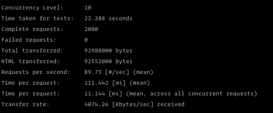使用过Python语言的朋友们可能使用过 forgery_py ,它是一个伪造数据的工具。能伪造一些常用的数据。在我们开发过程和效果展示是十分有用。但是没有Go语言版本的,所以就动手折腾吧。
从源码入手
在forgery_py的 PyPi 有一段的实例代码:
|
1
2
3
4
5
6
7
8
9
10
11
12
13
14
15
16
17
|
>>> import forgery_py>>> forgery_py.address.street_address()u'4358 Shopko Junction'>>> forgery_py.basic.hex_color()'3F0A59'>>> forgery_py.currency.description()u'Slovenia Tolars'>>> forgery_py.date.date()datetime.date(2012, 7, 27)>>> forgery_py.internet.email_address()u'brian@zazio.mil'>>> forgery_py.lorem_ipsum.title()u'Pretium nam rhoncus ultrices!'>>> forgery_py.name.full_name()u'Mary Peters'>>> forgery_py.personal.language()u'Hungarian' |
从以上的方法调用我们可以看出forgery_py下有一系列的 *.py 文件,里面有各种方法,实现各种功能,我们在来通过分析下Python版本的forgery_py的源码来看看它的实现原理。
|
1
2
3
4
5
|
# ForgeryPy 包的一级目录├── dictionaries # 伪造内容和来源目录,目录下存放的都是一些文本文件├── dictionaries_loader.py # 加载文件脚本├── forgery # 主目录,实现各种数据伪造功能,目录下存放的都是python文件├── __init__.py |
我们在来看下forgery目录下的脚本
|
1
2
3
4
5
6
7
8
9
10
11
12
13
|
$ cat name.pyimport randomfrom ..dictionaries_loader import get_dictionary__all__ = [ 'first_name', 'last_name', 'full_name', 'male_first_name', 'female_first_name', 'company_name', 'job_title', 'job_title_suffix', 'title', 'suffix', 'location', 'industry']def first_name(): """Random male of female first name.""" _dict = get_dictionary('male_first_names') _dict += get_dictionary('female_first_names') return random.choice(_dict).strip() |
__all__ 设置能被调用的方法。
first_name() 方法是forgery_py中一个典型伪造数据方法,我们只要来分析它就可以知道forgery_py的工作原理了。
这个方法代码很少,能容易就看出 _dict = get_dictionary('male_first_names') 和 _dict += get_dictionary('female_first_names') 获取的数据合并,在最后的 return random.choice(_dict).strip() 返回随机的数据。它的重点在于 get_dictionary() ,所以我们需要来看它的所在位置 dictionaries_loader.py 文件。
|
1
2
3
4
5
6
7
8
9
10
11
12
13
14
15
16
17
18
19
20
21
|
$ cat dictionaries_loaderimport randomDICTIONARIES_PATH = abspath(join(dirname(__file__), 'dictionaries'))dictionaries_cache = {}def get_dictionary(dict_name): """ Load a dictionary file ``dict_name`` (if it's not cached) and return its contents as an array of strings. """ global dictionaries_cache if dict_name not in dictionaries_cache: try: dictionary_file = codecs.open( join(DICTIONARIES_PATH, dict_name), 'r', 'utf-8' ) except IOError: None else: dictionaries_cache[dict_name] = dictionary_file.readlines() dictionary_file.close() return dictionaries_cache[dict_name] |
以上就是 dictionaries_loader.py 文件去掉注释后的所以要内容。它的主要实现就是:定义一个全局的字典参数 dictionaries_cache 作为缓存,然后定义方法 get_dictionary() 获取源数据, get_dictionary() 中每次forgery目录底下方法调用时先查看缓存,缓存字典中存在数据就直接输出,不存在就读取 dictionaries 底下的对应文件,并存入缓存。最后是返回数据。
总的来说forgery_py的原理就是:一个方法调用,去读内存中的缓存,存在就直接返回,不存在就到对应的文本文件中读取并写入缓存并返回。返回来的数据再随机选取输出结果。
使用Go语言实现
在了解了forgery_py的工作原理之后,我们就可以来使用Go语言来实现了。
|
1
2
3
4
5
6
|
# forgery的基本目录$ cat forgery├── dictionaries # 数据源│ ├── male_first_names├── name.go # 具体功能实现└── loader.go # 加载数据 |
根据python版本的我们也来创建对应的目录。
实现数据的读取的缓存:
|
1
2
3
4
5
6
7
8
9
10
11
12
13
14
15
16
17
18
19
20
21
22
23
24
25
26
27
28
29
30
31
32
33
34
35
36
37
38
39
40
41
42
43
44
45
46
|
// forgery/loader.gopackage forgeryimport ( "os" "io" "bufio" "math/rand" "time" "strings")// 全局的缓存mapvar dictionaries map[string][]string = make(map[string][]string)// 在获取数据之后随机输出func random(slice []string) string { rand.Seed(time.Now().UnixNano()) n := rand.Intn(len(slice)) return strings.TrimSpace(slice[n])}// 主要的数据加载方法func loader(name string) (slice []string, err error) { slice, ok := dictionaries[name] // 缓存中存在数据,直接返回 if ok { return slice, nil } // 读取对应文件 file, err := os.Open("./dictionaries/" + name) if err != nil { return slice, err } defer file.Close() rd := bufio.NewReader(file) for { line, err := rd.ReadString('\n') slice = append(slice, line) if err != nil || io.EOF == err { break } } dictionaries[name] = slice return slice, nil}// 统一的错误处理func checkErr(err error) (string, error) { return "", err} |
实现具体的功能:
|
1
2
3
4
5
6
7
8
9
10
|
// forgery/name.go// Random male of female first name.func FirstName() (string, error) { slice, err := loader("male_first_names") checkErr(err) slice1, err := loader("female_first_names") checkErr(err) slice = append(slice, slice1...) return random(slice), nil} |
这样就将python语言版本的forgery_py使用Go来实现了。
最后
上面只是提及了一些工作原理,具体的源代码可以看 https://github.com/xingyys/fo... ,也十分感谢 https://github.com/tomekwojci... ,具体的思路和里面的数据源都是他提供的。本人就是做了一些 翻译 的的工作。
总结
以上所述是小编给大家介绍的Go语言版本的forgery,希望对大家有所帮助,如果大家有任何疑问请给我留言,小编会及时回复大家的。在此也非常感谢大家对服务器之家网站的支持!
原文链接:https://studygolang.com/articles/14065












